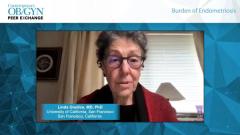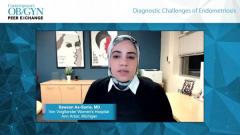
Main Types of Endometriosis
Sawsan As-Sanie, MD, Jessica Shim, MD, Robert Taylor, MD, PhD, and Linda Giudice, MD, PhD, discuss the 3 main types of endometriosis and the commonly associated symptoms and risk factors.
Episodes in this series

Hugh Taylor, MD: We typically define endometriosis as ectopic endometrial glands and stroma, but a simple definition belies the complexity of the disease. We see different types of endometriosis and treat them differently. Rob, would you comment on the different types of endometriosis that are clinically recognized?
Robert Taylor, MD, PhD: There are 3 categories we’ve focused on: peritoneal disease, ovarian disease, and deeply infiltrating endometriosis, where we’re looking at invasion more than a few millimeters through the peritoneal surface. Those have been the general categories, but if one wanted to think about it more broadly, we’ve got distant extra peritoneal on a much less common form of endometriosis, but that’s 1 that certainly seems like it could be quite different as well. These categories are helpful from an academic point of view. Whether the diseases are functionally or physiologically different processes, that’s a little harder to understand.
It’s helpful for us to categorize these patients with these various approaches, but at the end of the day, to understand the biology of the disease, we ought to consider all the different types and not exclude any. Obviously, the pain has been more associated with the deeply infiltrative forms of endometriosis. It’s been argued that ovarian endometriomas are not associated with so much pain, although a number of us have seen exceptions. These are helpful for our categorization but might not help us understand the disease a lot more.
Hugh Taylor, MD: Sawsan, I’ll throw it over to you. You’re our pain expert, do you agree? Do you see less pain with certain forms of disease and more pain with the deeply infiltrated endometriosis vs endometrioma?
Sawsan As-Sanie, MD: That’s a great question. The data point to not strong correlations between the severity of pain symptoms and the presence, location, and subtype of endometriosis. It’s surprising though, because we make these assertations based on not very huge sample sizes. But the takeaway clinical message to patients is that you can have any form of endometriosis in any degree of pain, and how much endometriosis you have doesn’t necessarily predict the type or location or the pattern of pain you have. The 1 place where the data are most strongly associated with location and severity of endometriosis and pain is in patients who have deep endometriosis in the cul-de-sac. They have a strong correlation with having dyspareunia or pain with vaginal penetration. That’s something we need to be aware of, but in general, endometriosis in any location in any severity warrants assessment, evaluation, and our attention.
I agree with Dr Taylor in that the classification is really helpful, so we can communicate with one another and understand the location and the type of disease. That certainly helps with surgical planning and helps us follow patients over the long term. But there’s so much work to be done to understand how it relates to etiology and how well patients respond to treatments. Those are all really good points.
Hugh Taylor, MD: Let’s go back to some basics. Jessica, in your patients, what are the typical presenting symptoms in patients with endometriosis? What are you looking for that may make you think this patient has endometriosis?
Jessica Shim, MD: Many patients will have reported dysmenorrhea, but a lot also report pelvic pain symptoms, besides dysmenorrhea. There’s 1 study that found that the majority of adolescents will have this acyclic pelvic pain with or without cycling of pelvic pain with their period. I like to emphasize that the pain can withstand the menstrual cycle. The other thing I happen to notice is how limited a lot of adolescents may be in their functionality from their endometriosis-associated pain symptoms. A lot of kids are missing out on school or sports or social activities, and that’s a red flag for me.
Hugh Taylor, MD: My antenna goes up anytime somebody talks about their dysmenorrhea becoming progressively worse. Hopefully, we can catch it before they limit their school activity or miss days of school or work. But anytime somebody has progressively worsening dysmenorrhea, I’m concerned and start to think [it might be] endometriosis. Linda, can you discuss some of the risk factors for endometriosis? What risk factors would we look for that might also make us suspicious that this could be endometriosis?
Linda Giudice, MD, PhD: It’s thought that 50% of risk is genetic and 50% is environmental. Although there haven’t been specific environmental triggers identified, if we could identify them, we could potentially prevent disease. Asking for family history is really important. You’d be surprised how many families have a mother, sister, or aunt with endometriosis, or they may have had a hysterectomy not quite diagnosed many years ago. Also, having early menarche and prolonged exposure to estrogen over the life course increases the risk of endometriosis. There are associations of endometriosis with other diseases that are associated with inflammation, autoimmunity, and certainly a role of the immune system, but we don’t know the impact of the risk factors in terms of promoting progression or initiation or and progression of the disease.
Hugh Taylor, MD: Your point about asking about family history and for a diagnosis of endometriosis is important. Often they’ll say no, but they have a mother, a sister, or an aunt who had debilitating painful periods that went away when they became pregnant or after their hysterectomy for some unknown reason. It’s very important to ask about that full history.
TRANSCRIPT EDITED FOR CLARITY
Newsletter
Get the latest clinical updates, case studies, and expert commentary in obstetric and gynecologic care. Sign up now to stay informed.

























